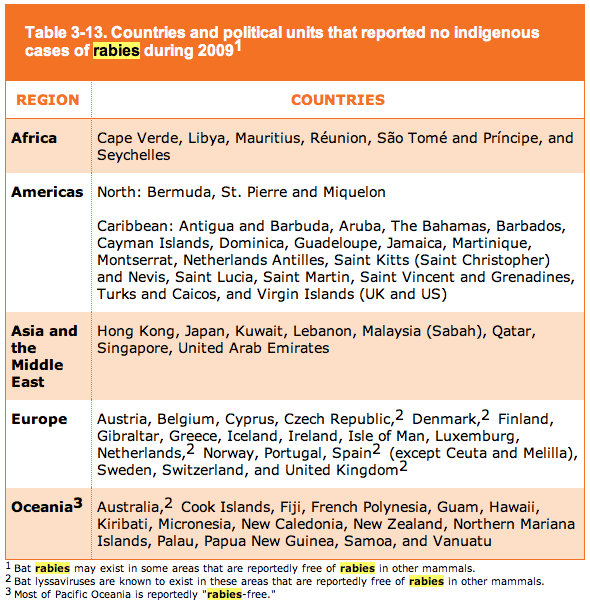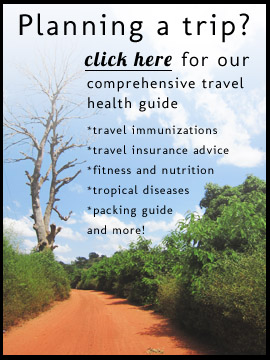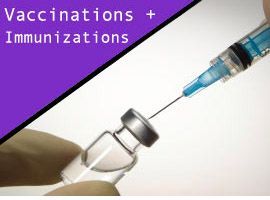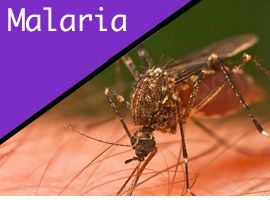First things first, as we mentioned in our article on travel immunizations, rabies is something that should be discussed with a doctor at a travel health clinic. Travelers rarely get rabies, but it is a potentially fatal disease and it exists almost everywhere in the world.
This article will cover how to prevent and treat rabies, along with basic information about how the disease works and the risk that exists for travelers.
How the Rabies Virus Works
Rabies is a latin word meaning madness. If you know anything about the life cycle of the rabies virus, you can understand this word choice. Rabies is zoonotic, a fancy word that tells you it is a disease transmitted by animals. In the case of rabies, mammals are the only animals that can get infected by it. If an infected animal bites, scratches or licks you, there is a chance you will become infected yourself (the chances of transmission are much higher with a bite).
Once in your body, the rabies virus works its way to your central nervous system. This can take several months or much less. If there is a deep bite, the virus will arrive in the central nervous system much quicker. Once in the central nervous system, symptoms begin to appear and eventually the virus will cause inflammation of the brain, also known as encephalitis, at which point you will probably die. Without treatment before the symptoms begin, rabies is fatal in over 99% of cases.
Signs and Symptoms of Rabies
 Rabies symptoms are initially flu-like, but they quickly worsen and turn into insomnia, anxiety, confusion, paranoia, agitation, terror, hallucinations, and partial paralysis. Had enough? If not, all you need to know is that rabies typically causes death 2 to 10 days after symptoms appear. And all those stories about salivating at the mouth? They are true. Excessive production of saliva and tears and an inability to swallow or speak are real possibilities in the late stages of the disease.
Rabies symptoms are initially flu-like, but they quickly worsen and turn into insomnia, anxiety, confusion, paranoia, agitation, terror, hallucinations, and partial paralysis. Had enough? If not, all you need to know is that rabies typically causes death 2 to 10 days after symptoms appear. And all those stories about salivating at the mouth? They are true. Excessive production of saliva and tears and an inability to swallow or speak are real possibilities in the late stages of the disease.
Avoiding and Preventing Rabies
Travelers rarely get rabies. Even so, every traveler should follow these guidelines:
- Avoid contact with animals, specifically mammals. Be especially careful around stray animals. Do not approach them, do not touch them. If an animal is acting especially strange (walking irregularly, acting aggressively, salivating), keep your distance.
- Have a basic understanding of your surroundings at all times so that you do not accidentally stumble upon a stray animal, which could surprise it and cause it to become aggressive.
- If you are going caving, do not try to handle or make contact with bats (like you would want to do this anyway?).
- The rabies vaccination, which we wrote about in our article on travel immunizations, is a series of three injections that does not confer immunity, but it reduces the amount of post exposure treatment you need if you are bitten by an animal. In other words, you still need to get treatment whether you have been vaccinated or not. You just need less treatment if you’ve been vaccinated before hand.
Treating Rabies
- If you have been bitten, scratched or licked by a mammal that you are unfamiliar with, you need to assume it was infected with rabies and act accordingly (unless you can somehow secure the animal and take it to a vet where it can be tested).
- Clean the wound with soap and water and a strong antiseptic like alcohol.
- Seek treatment from a clinic as soon as possible. Treatment within 48 hours is considered 100% effective. Remember, you need to get treatment even if you have been vaccinated. If you have been vaccinated, you will receive 2 booster injections of the vaccine as post-exposure treatment. If you have not been vaccinated, you will need an injection of rabies immune globulin (RIG) and at least 4 injections of the rabies vaccine (given over a period of 14 days).
Should you get vaccinated for rabies if you are a traveler?
We touched on the debate over vaccination in our travel immunizations article. On the one hand, the rabies vaccine is expensive, involves 3 injections, and treatment is still required even if you get it. On the other hand, the rabies vaccine buys you more time to seek treatment and it ensures that the treatment is less involved and less expensive.
Another thing to consider is that if you have not been vaccinated and you have been bitten by an animal, your course of treatment will include rabies immune globulin (RIG), whereas RIG is not required if you have been vaccinated before hand. RIG is expensive and in some cases it is not readily available. If you are in a rural area, the closest clinic might not have it.
If we were traveling to a rural area and planning on having contact with animals, we would get a rabies vaccination without thinking twice. If we are spending most of our time in urban areas and we don’t plan on spending time around animals, the risk is far less. But as we said at the beginning of the article, this is something that you need to discuss with a doctor. Along with getting travel health insurance, you should make a point of visiting a travel health clinic before you leave for your trip.
Below is a table from the CDC indicating where there were no reported cases of rabies in 2009.
Be sure to read the small print on the table above. Bat lyssavirus is a virus related to rabies and the treatment and vaccination process is the same for both.
Additional Rabies Facts
– To date, 3 people in the U.S. have survived the rabies virus without post-exposure treatment. The most recent case was an 8-year-old California girl. Read about the case here.
– According to the WHO, more than 55,000 people die from rabies every year. They estimate that 327,000 deaths are prevented every year by people who receive post-exposure treatment.
– In some countries, rabies is only found in certain bat populations.
– Humans have been aware of rabies since 2000 BC.
Photo credit for the post photo. Additional photos from Wikipedia.













{ 0 comments… add one }